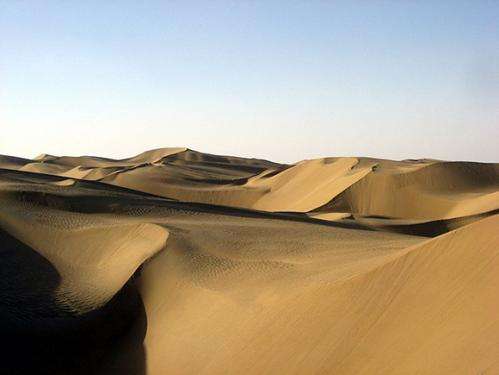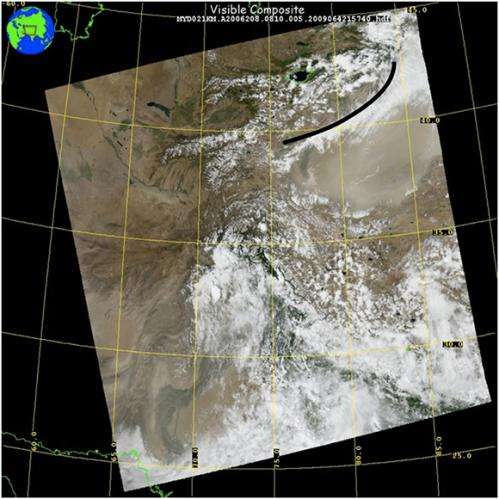Wind and cold carry dust to new heights

(Phys.org) —Scientists at China's Lanzhou University and Pacific Northwest National Laboratory found that dust lifted from the Taklimakan Desert during a dust storm had a significant effect on the regional climate. The 2006 storm was aggravated by a cold front that pushed the dust to the highest level of the atmosphere over the northern Tibetan Plateau in China, affecting the balance of heat in the region's atmosphere. The ability to accurately model such storms will help in understanding the climatic impact of dust.
The Tibetan Plateau in China's Himalayan region has one of the world's largest stores of ice. As increasing ice melt over the plateau swells rivers and lakes, it also increases the amount of land in the region. The additional land mass acts as a heat pump drawing heat out of the atmosphere, increasing the intensity and duration of regional monsoons. Worldwide, monsoons provide half the Earth's population with fresh water. They also impact the world's climate via the global circulation.
The addition of dust blowing over the plateau heats the lower atmosphere, fueling the heat pump effect. In addition, when dust falls on the plateau's snow and ice, it absorbs the sun's energy and stimulates melting. In this study, results show that increasing dust over the region points to significant change the atmospheric circulation and the Asian monsoon climate.
The researchers studied the effects of a large dust storm from the Taklimakan Desert (TD) that occurred July 21-30 in 2006. The dust swept over the northern slope of the Tibetan Plateau (TP), the world's third largest ice mass. The collaborators used the Weather Research and Forecasting model with chemistry (WRF-Chem) to simulate the event.

They examined the synoptic weather systems and dust transport pathway during the dust storm and estimated the shortwave and longwave radiative forcings of TD dust transported over the TP. During a typical summer, the heat radiating from the TP and weak East Asian westerly winds ripens conditions for a dust event. During the event in 2006, the conditions were further pushed by a strong cold front system over the TD. The dust broke through the planetary boundary layer and extended to the upper troposphere over the northern slope of the TP.
This study shows that the dust radiative forcing modified the surface and TOA energy budget and atmospheric heating profile, which can modulate the stability of the atmosphere as well as surface sensible and latent heating to increase the role of the TP as a heat pump.
Researchers want to understand the worldwide climatic influence of the Taklimakan Desert, a major source of dust that ultimately travels long distances. Scientists plan to characterize the seasonal aspect of dust emissions and transport. Further, they will investigate how dust interacts with and changes clouds in its path, and how dust landing on snow changes the regional climate.
More information: Chen, S. et al. 2013. Modeling the transport and radiative forcing of Taklimakan dust over the Tibetan Plateau: A case study in the summer of 2006, Journal of Geophysical Research 118(2) 797-812. DOI:10.1002/jgrd.50122.
Journal information: Journal of Geophysical Research
Provided by Pacific Northwest National Laboratory




















